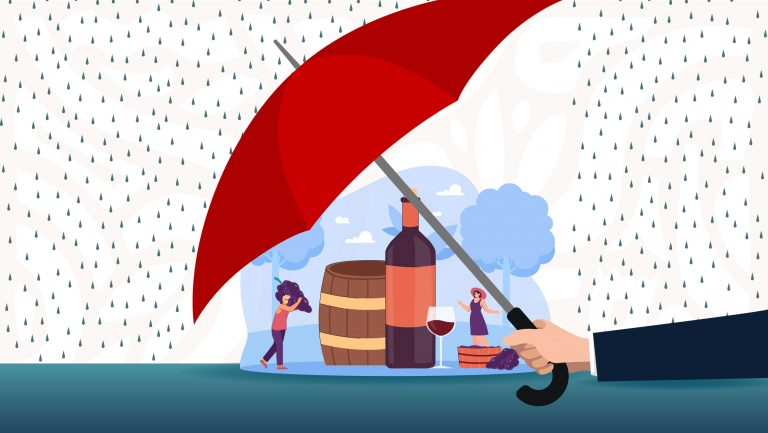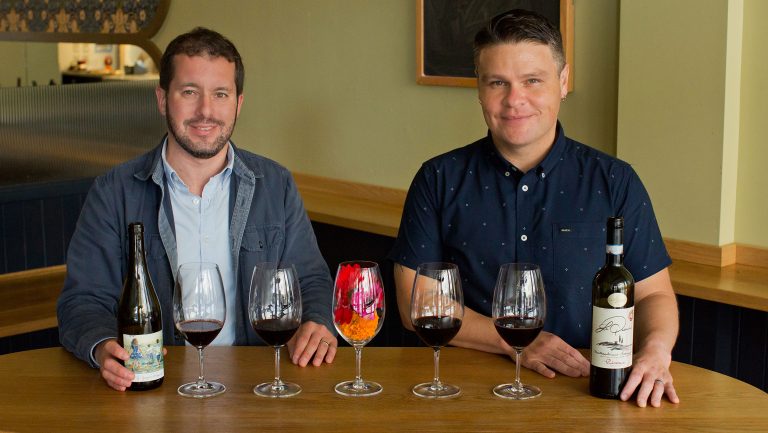“In the insurance industry, we talk about 100-year events and 500-year events,” says Larry Chasin, the CEO of PAK Programs, which provides insurance across the beverage alcohol industry. “But now we’re talking about that every year. It’s really not a 100-year event. It’s a primary peril.” As disasters like the Glass Fire that ravaged Napa in 2020 and the devastating frosts that hit New York State vineyards in May become more and more common, winery and vineyard owners are discovering they need more insurance than they thought, and they’re paying more for it. Eventually, that cost finds its way into the bottle, too.
The powerful image of fires sweeping across vineyards might cause some people to focus on the damage to grapes, but Chasin says crop insurance is only one corner of a dense web of coverage within the wine industry. Farmers, manufacturers, retailers, wholesalers, hospitality operators, and wineries contend with a wide range of risk exposure, which is further complicated by the presence and consumption of alcohol on site. Claims—and with them, rates—have skyrocketed in the past several years thanks to issues ranging from climate change to supply chain problems; Chasin says there has been about a billion dollars’ worth of winery and viticultural claims filed in California since 2017.
These claims could be for damage to a winery and its equipment or vineyards, or to the wine in the tank, barrels, or bottles. “A significant winery is going to have multiple years of product on hand,” says Chasin. “Whether it’s in a cave or a warehouse or a manufacturing building, when you have multiple years of sales piled up in a warehouse, the values get significant quick. There’s a lot of indirect loss as well. Things like road closures; your staff can’t get there, so your tasting rooms can’t open. You can’t sell anything.”

Don’t miss the latest drinks industry news and insights. Sign up for our award-winning newsletters and get insider intel, resources, and trends delivered to your inbox every week.
In addition to the sudden profusion of 100-year events like fires, frosts, and hailstorms, the pandemic has also impacted insurance claims. “It’s affected labor and rebuilding costs,” says Chasin, “so where you might have scheduled [insured] a building for a million dollars before, it could very well cost two million to rebuild in this environment.” Wineries are discovering they need greater coverage than before if they want insurance that will make them whole after a loss. But with disaster stories becoming an annual happening, wineries are biting the bullet.
The scale of the claims is putting strains on the system. In places like Napa and Sonoma, the risk is highly concentrated, and the insurance industry is becoming reluctant to cover risks that could result in huge claim payments. Michael Terrien, the cofounder of Obsidian Wine Co. in the Santa Cruz Mountains, another area considered higher risk, says insurers have twice dropped coverage on his project U.S. Grant Wines, each time resulting in higher premiums with the new insurer. It’s a cost that eventually has to be factored into the price of the wine.
Insurance in the Vineyard
“In 2020, we had the smoke,” says John Grochau, the founder and head winemaker at GC Wines in Oregon. “And then in ’21 or ’22, we had a large spring frost. So there’s been a couple major events in the last three years that have growers thinking, ‘well maybe I should look at this crop insurance thing.’”
Crop insurance, which compensates for damage to the actual grapes in the vineyard due to things like hail, frost, and fire, is often the first thing people think of when winery and vineyard insurance comes up, but it hasn’t always been popular with growers. It’s taken the increased number of threats and damages to drive more growers to purchase coverage.
“Oftentimes the payment for the loss of the crop doesn’t even cover the cost of farming, let alone the loss of business income because you couldn’t make that product.” – Larry Chasin, PAK Programs
“The challenge with crop insurance is that it’s set on average values,” says Chasin. In areas like Sonoma and Napa, where crop values are exceedingly high, growers have found that crop insurance doesn’t fully cover their losses. “Oftentimes the payment for the loss of the crop doesn’t even cover the cost of farming, let alone the loss of business income because you couldn’t make that product.” Filing claims can also be difficult; just as car insurance in many states requires determining fault before a claim will be paid, growers filing crop insurance claims have to prove that they did what they could to avoid the loss and took proper prevention measures, such as choosing appropriate picking times.
GC Wines operates on a négociant model, and Grochau says they’ve seen grape prices increase as growers take on insurance. He’s okay with that. “It’s a relationship, and especially since I don’t own any land, I’m nothing without my growers,” he says. “It’s always a team effort, so them having crop insurance puts less pressure on me to make them whole if there’s a fire that greatly hampers the quality of the grapes and the wine.” Grochau acknowledges that an increase in grape prices makes it challenging for him to get his wines to market at the price point he’s aiming for. As a result, he’s had to increase his prices.
Terrien calls federally subsidized programs, which make it easier for insurers like PAK Programs to afford providing coverage, a “no-brainer,” and says they’ve benefited from claims against frost and smoke damage in their Lake County vineyards in the past. While insurance premiums can drive up costs, so can lost crops. “When a winery loses a crop to smoke taint, as Obsidian did in 2018 and 2020, it becomes necessary to accommodate the loss with price increases,” he says. “In the background, insurance premiums have an incremental impact on the bottle price, just as with inflationary pressure on margins from cost of goods and overhead.” Wine prices are creeping up, and greater insurance costs is one of the factors making that happen.

Utilizing Insurance at the Wholesale Level
Outside of the wineries themselves, importers and shippers are seeing rising insurance costs tied to the global shipping crisis—costs that eventually make their way into pricing decisions. The Wine and Spirits Shippers Association (WSSA) offers insurance policies to its members. “From the WSSA point of view,” says program manager Gretchen Veevaert, “since the pandemic, we have seen an increase in the volume of cargo we have insured, not only from customers increasing their imports, but also because more shippers are realizing the value of risk management during this economic crisis.”
Claims in the supply chain can range from small issues such as a road accident or packaging error that damages a few bottles to larger problems where a whole container can be declared a loss due to heat damage. “We did see a number of those claims with the port backups, where cased goods were left without the proper temperature controls,” says Chasin.
There’s also the problem of more deliberate, intentional losses. “We have seen an increase of theft in certain regions of the world,” says Veervaert. “And because of that, we have had to monitor those regions closely. These incidents have appeared to be organized and deliberate, and we have responded to the issues by hiring professional investigators and implementing extra security precautions for shipments moving within those regions.” Chasin reports similar problems domestically. “Delivery trucks are pulling away from the warehouses full of case goods, never to be seen again. It’s concerning to us because the value adds up quickly and it’s proven to be quite a sophisticated operation.”
There’s ever more reasons for wineries and importers to invest in insurance. But even then, they still have to live with the fact that an insurance claim can’t fix everything. “Insurance is not going to cover things like lost spots on lists and shelves,” says Grochau. “Those kind things have a long-term effect on the brand. Or worse yet, nobody really notices the damage until it gets to the shelf. That’s the worst, because then people just think your wine’s not good.”

Dispatch
Sign up for our award-winning newsletter
Don’t miss the latest drinks industry news and insights—delivered to your inbox every week.
Jim Clarke writes about wine, beer, and spirits for trade and consumer publications, including Beverage Media, Fortune, and World of Fine Wine. He is a sommelier and the U.S. marketing manager for Wines of South Africa.







